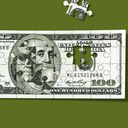The Federal Reserve has created a make-believe economy that benefits the top

The Federal Reserve and global central banks are remaking the world's economy in an effort to save it, but have created something of a monster.
Why it matters: The Fed-driven economy relies on the creation of trillions of dollars — literally out of thin air — that are used to purchase bonds and push money into a pandemic-ravaged economy that has long been dependent on free cash and is only growing more addicted.
- However, most of the money gets stuck at the top — winding up in the accounts of large corporations and highly paid executives, while leaving behind small businesses and everyday Americans.
What's happening: Stocks are hitting all-time highs while millions remain out of work and on unemployment insurance. That's not a coincidence.
- Companies' lean bottom lines (i.e. shortage of expensive workers) are a major reason investors are so bullish on equity prices.
How it works: It's cheaper than ever for companies to borrow money because the Fed has set interest rates at effectively 0% and has promised to buy unlimited government bonds and an unspecified amount of corporate bonds. So companies have issued unprecedented debt and loaded up their balance sheets.
- But they're not using their Fed-backed cash piles to hire more workers or increase salaries. In fact, many are doing the opposite — driving down their "operating leverage" by "cost cutting through labor force reduction and refinancing of debt," notes John Lynch, chief investment officer at Comerica Asset Management.
- Add to that years of companies buying back their own shares to juice stock prices higher, and "we essentially have more dollars chasing fewer shares because of buybacks and [the Fed's] liquidity increases," Lynch tells Axios.
Between the lines: It's a Goldilocks environment for stocks, but a bearish one for workers.
- Because executive pay is largely determined by companies' stock prices, it's much more lucrative for top execs to buy back their stock than it is to hire more workers or invest in projects that require a larger workforce.
The big picture: Even with all the Fed has done, the economy is still too weak to stand on its own, economists argue.
- "It’s easy to forget how weak much of the underlying economy is when we see a booming stock market and good data coming from areas such as housing and manufacturing," Robert Frick, corporate economist at Navy Federal Credit Union, tells Axios.
- "But with sectors of the economy such as travel, restaurants and lodging still beaten down by the pandemic, and more than 10 million Americans unemployed who had jobs in February, those low interest rates and other Fed supports are obviously needed to keep the economy from slipping back into recession."
Watch this space: During his testimony with the House Financial Services Committee Wednesday, Powell assured Congress that the Fed would remain on its current policy path "well into the future."
The bottom line: "The socialization of debt by the Fed is fundamentally reshaping how the quote 'free market' system works," Scott Minerd, CIO at Guggenheim Partners, told Axios last month.
- "And as Milton Friedman said, nothing is so permanent as a temporary government program."